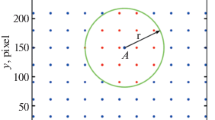Abstract
White-light speckle photography was applied to measure the viscoplastic deformation of a proposed nuclear-waste repository. The repository vaults are carved into bedded salt deep in the earth, and deform extremely slowly. The research demonstrates the feasibility of using whole-field techniques to detect mine wall strains, confirms certain, but not all, measurements of point-by-point instruments, and also confirms the predictions of a site-specific numerical model.
Similar content being viewed by others
References
Speckle Metrology, ed. R. Erf, Academic Press (1978).
Conley, E. andCloud, G., “Whole-Field Interferometric Scheme to Measure Strain Rates in Glacier Ice and Other Naturally Occurring Surfaces,”J. Glaciology, Cambridge, England,29 (103),492–497 (1983).
Conley, E. andCloud, G., “Practical Applications of Double-Exposure Noncoherent Speckle Photography,”Appl. Opt. 25 (14),2247–2249 (July1986).
Conley, E. andCloud, G., “Enhancing Sensitivity of the White-light Speckle Method in Terrestrial Applications,Experimental Mechanics,29 (2),138–143 (June1989).
Conley, E. andGenin, J., Application of Speckle Metrology at a Nuclear Waste Repository, Proc. Soc. Photo-Optical Instr. Eng. (SPIE),1332,798–802 (July1990).
Industrial Uses for Optical Data Processing and Holography, eds. E. Conley and J. Robillard, CRC Press, ISBN 0-8493-0139-4 (1992).
Conley, E., Barham, L. and Fink, C., Nuclear Waste Repository Vault Closure Measurements—Technique and Application, Proc. Associated Western Univ. EMCORE Tech. Prog. Review (Aug. 1992).
Huntley, J., “Speckle Photography Fringe Analysis: Assessment of Current Algorithms,”Appl. Opt. 28 (20),4316–4322 (Oct.1989).
Huntley, J., “An Image Processing System for the Analysis of Speckle Photographs,”J. Physics E,19,43–48 (1989).
Chu, T. et al., “Applications of Digital-image-correlation Techniques to Experimental Mechanics,”Experimental Mechanics,25,232–244 (1985).
Asundi, A. andChiang, F., “Theory and Applications of the White light Speckle Method for Strain Analysis,”Opt. Eng. 21 (4),570–580 (July/Aug.1982).
Munson, D.E. et al., Geomechanical Evaluation (Room G): In Situ Data Report (Dec. 1984–Nov. 1990), Sandia Report SAND92-0582, WIPP Thermal/Structural Interactions Program, 71 (1992).
Vikram, C. andVedam, K., “Processing Speckle Photography Data: Circular Imaging Aperture,”Appl. Opt. 22 (5),654 (March1983).
Kauffman, G., “On the Numerical Procession of Speckle Photograph Fringes,” Opt. and Laser Tech., 207–209 (Aug. 1980).
Hinsch, K., “Fringe Positions in Double-Exposure Speckle Photography,”Appl. Opt.,28 (24),5298–5304 (Dec.1989).
DOE/WIPP92-010 Geotechnical Field Data and Analysis Report,1,1–6 (March 1992).
DeVries, K.L., RES/SPEC Inc., Rapid City, SD, Comparison of WIPP Disposal Room Analysis Results Using Small and Large Deformation Formulations. Memorandum RSI(RCO)-262/293 to D.E. Munson. Sandia National Lab. (Feb. 1993).
DeVries, K.L., RES/SPEC Inc., Rapid City, SD, Gradation of Closure Along Disposal Room Surface, External Memorandum RIS(RCO)-262/8-93/7 to D.E. Munson, Sandia National Labs. (Aug. 1993).
Author information
Authors and Affiliations
Rights and permissions
About this article
Cite this article
Barham, L., Baher, C. & Conley, E. Speckle-photography study of nuclear-waste vault deformations. Experimental Mechanics 36, 42–48 (1996). https://doi.org/10.1007/BF02328696
Received:
Accepted:
Issue Date:
DOI: https://doi.org/10.1007/BF02328696



